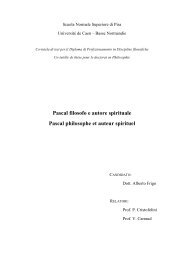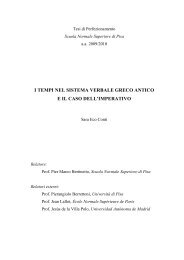CATULLUS 68 - Scuola Normale Superiore
CATULLUS 68 - Scuola Normale Superiore
CATULLUS 68 - Scuola Normale Superiore
You also want an ePaper? Increase the reach of your titles
YUMPU automatically turns print PDFs into web optimized ePapers that Google loves.
Hist. 5.20.1 pluribus nuntiis huc illuc cursantem and Ann. 15.50 cum ardente domo huc illuc cursaret<br />
incustoditus. circumcurso is only attested during the Republic (also at Pl. Rud. 233, Ter. Heaut. 512, Lucr.<br />
4.400) and late antiquity (see TLL 3.1127.43-63), while circumcurro is rare in the Classical period (1x<br />
Vitruv., 1x Quint., perhaps 1x in tmesi in Verg. Aen.). The intensive aptly describes a child running to and<br />
fro: compare Tib. 1.10.16 cursarem uestros cum tener ante pedes.<br />
134 fulgebat crocina candidus in tunica recalls lines 70f. quo mea se molli candida diua pede / intulit et<br />
trito fulgentem in limine plantam: Lesbia’s spellbinding beauty is mirrored by youthful looks and the divine<br />
gleam of the god of Love.<br />
crocina … in tunica Cupid is wearing a saffron-coloured tunic. In visual art the god is practically always<br />
depicted naked from Attic vase-painting onwards (see LIMC s.v. ‘Eros’ and ‘Eros/Amor, Cupido’) and his<br />
nudity is a commonplace in Augustan poetry (cfr. Prop. 1.2.8 nudus Amor formae non amat artificem, Ov.<br />
Am. 1.10.15 et puer est et nudus amor and Met. 10.515f. qualia … / corpora nudorum tabula pinguntur<br />
Amorum). Curiously, he does not appear to be called naked in Greek literature before Moschus 1.15 γυμν∫!<br />
⎟λο! τ〉 γε σ∩μα (see further Fedeli 1980 on Prop. 1.2.8 and Mantero 1979: 175): for example, when Plato<br />
describes the god in detail in the Symposium (203c-d), he calls him unshod but not naked. Earlier still,<br />
Sappho frg. 54 Voigt had described Eros as ƒλψοντ ⁄ϕ ⎮ρ νϖ πορφυρ⇔αν περψϒμενον ξλ μυν.<br />
Catullus may well be following her here. It is not particularly surprising that he lets the god wear not a<br />
ξλ μυ! but a tunica, the vest-like Roman garment worn under the toga by adult citizens but also on its own<br />
by young boys (see Wilson 1938: 55-69, and note especially plate XLII, which depicts a bronze statue of a<br />
young boy wearing a tunica, conserved in the Capitoline Museum at Rome); the young sons of Roman<br />
citizens could also wear a toga praetexta, but that would hardly have suited an airborne young god.<br />
However, the tunic worn by most Romans was plain white, with or without a purple stripe, while that of<br />
Cupid is croceus, ‘saffron-coloured’, that is, orange (on the colour see André 1949: 153-155). According to<br />
Baehrens and Kroll, it has this colour for the sake of the contrast with Cupid’s skin, as at 61.9f. niueo gerens<br />
/ luteum pede soccum (of the orange-yellow socks of Hymenaeus, the god of marriage); but such a marked<br />
deviation from the norm of white and purple dress calls for a less casual explanation.<br />
Here Cupid is wearing a saffron-coloured tunic, while in poem 61 the socks of the god of marriage are<br />
orange-red: croceus and luteus evidently referred in origin to shades of yellow obtained with dyes prepared<br />
from different plants, the saffron (crocus – see RE s.v. ‘Saffran’), or rather its stamina, and the weld (lutum).<br />
Pliny makes an interesting observation about the latter colour: lutei uideo honorem antiquissimum, in<br />
nuptialibus flammeis totum feminis concessum, et fortassis ideo non numerari inter principales, hoc est<br />
communes maribus ac feminis, quoniam societas principatum dedit (N.H. 21.46), that is, luteum was the<br />
traditional colour of the nuptial veil (on which see Rage-Brocard 1934: 22 and n. 2 with references, though<br />
the scholiast on Juv. 6.225 who calls the flammea [sic!] sanguineum may be misinformed). Pliny guesses that<br />
it might be as a result of this custom that the colour is not worn ordinarily by Roman men and women. Ovid<br />
Met. 10.1f. croceo uelatus amictu … Hymenaeus describes the god of marriage as wearing saffron-coloured<br />
228






